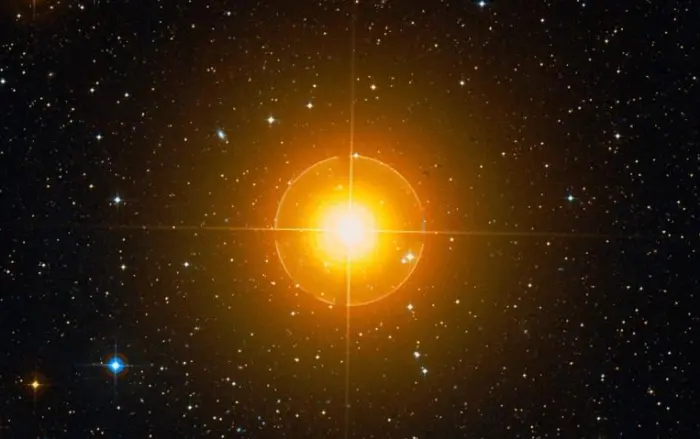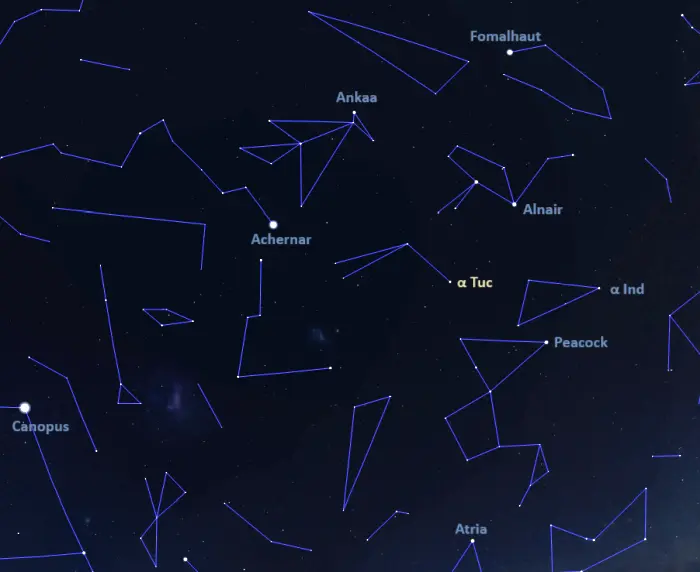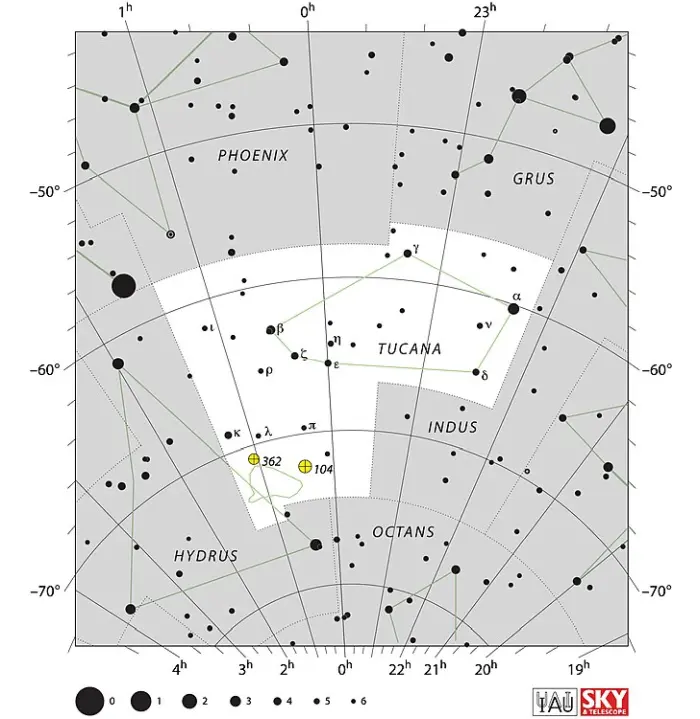Lang-Exster, Alpha Tucanae (α Tuc), is an orange giant star located approximately 184 light-years away in the southern constellation Tucana. With an apparent magnitude of 2.86, it is the constellation’s brightest star. It marks the celestial Toucan’s head.
Star system
Alpha Tucanae is a spectroscopic binary star composed of an orange giant of the spectral type K3 III and a companion whose presence can only be inferred from the changes of the primary component’s spectrum. The two stars orbit each other with a period of 4,197.7 days (11.5 years).
The primary star, Alpha Tucanae A, has a mass of 2.5 – 3 solar masses. As it burned through its supply of hydrogen and evolved away from the main sequence, the star expanded to a size of 37 solar radii. With an effective temperature of 4,300 K, it shines with 424 solar luminosities.

Lang-Exster (Alpha Tucanae), image credit: ESO/Digitized Sky Survey 2 (CC BY 4.0)
Facts
In Chinese astronomy, Alpha Tucanae was known as the First Star of Bird’s Beak. Bird’s Beak (鳥喙, Niǎo huì) was an asterism formed by Alpha Tucanae with Delta Tucanae, HIP 118092, Beta Tucanae, Rho Tucanae, Zeta Tucanae, and Epsilon Tucanae. Stars in the far southern sky were not known to Chinese observers in ancient times. They were only catalogued after the arrival of western star maps. Bird’s Beak was one of the asterisms added in the early 17th century.
Name
Alpha Tucanae A has the proper name Lang-Exster. The name comes from the description of the constellation Tucana by the Dutch navigator Frederick de Houtman when the constellation was created in the late 16th century. De Houtman called it, Den Indiaenschen Exster, op Indies Lang ghenaemt, meaning “the Indian magpie, named Lang in the Indies.” He was likely describing the hornbill (lang), an exotic bird native to Malaysia and the East Indies.
The International Astronomical Union’s (IAU) Working Group on Star Names (WGSN) formally approved the name on September 19, 2024.
Location
Alpha Tucanae is the brightest point of light between the brighter Achernar in Eridanus and Peacock in Pavo. It appears within the triangle formed by Achernar, Peacock and Fomalhaut in Piscis Austrinus.
The brightest stars of the Southern Birds constellations – Ankaa in Phoenix, Alnair in Grus, Lang-Exster in Tucana, and Peacock in Pavo – form an elongated quadrilateral pattern that makes them easy to identify.
At declination -60°, Alpha Tucanae never rises for observers north of the latitude 30° N. It is best seen from the southern hemisphere.

The location of Alpha Tucanae (Lang-Exster), image: Stellarium
Constellation
Lang-Exster is located in the constellation Tucana. Representing the Toucan, Tucana was one of the 12 constellations created by the Dutch-Flemish astronomer and cartographer Petrus Plancius in the late 16th century. Plancius created the new southern constellations based on the observations of Dutch explorers Pieter Dirkszoon Keyser and Frederick de Houtman.
Tucana was one of the constellations that were introduced in German astronomer Johann Bayer’s star atlas Uranometria in 1603, along with Apus (the Bird of Paradise), Volans (the Flying Fish), Hydrus (the Lesser Water Snake), Grus (the Crane), Dorado (the Dolphinfish), Indus (the Indian), and several others.
Tucana is not particularly prominent. It is the 48th largest constellation in the sky, stretching across only 295 square degrees in the region near Octans and the southern celestial pole. It is one of the four southern constellations collectively known as the Southern Birds. The other three are Grus (the Crane), Phoenix (the Phoenix), and Pavo (the Peacock).

Tucana constellation map, by IAU and Sky&Telescope magazine (Roger Sinnott & Rick Fienberg) (CC BY 3.0)
Alpha Tucanae, the brightest star in Tucana, is the only third magnitude star in the constellation. The evolved F-type star Gamma Tucanae, Tucana’s second brightest star, is a full magnitude fainter (mag. 3.99).
Other notable stars in Tucana include the F-type star Zeta Tucanae, the multiple star systems Kappa Tucanae and Beta Tucanae, the hot blue star Epsilon Tucanae, the binary system Delta Tucanae, the variable red giant Nu Tucanae, and the variable yellow giant Iota Tucanae. Tucana also hosts the G-type star HD 213885 and K-type star HD 215497, both of which host two orbiting exoplanets.
Deep sky objects in Tucana include a portion of the Small Magellanic Cloud (SMC), a dwarf irregular galaxy in the Local Group, 47 Tucanae, the second brightest globular cluster in the sky (after Omega Centauri), the globular clusters NGC 362 (Caldwell 104) and NGC 121, the Tucana Dwarf Galaxy, and the barred spiral galaxy NGC 7408.
Notable stars in the Small Magellanic Cloud include the massive star system HD 5980, which contains a luminous blue variable, a Wolf-Rayet star, and a blue supergiant, the binary star AB7, composed of a Wolf-Rayet star and an O-type supergiant, the red supergiant PMMR 62, the luminous blue variable R40, and the yellow hypergiant HD 7583.
The best time of the year to see the stars and deep sky objects in Tucana is during the month of November, when the constellation appears higher above the horizon in the early evening. The entire constellation is visible from locations between the latitudes 25° N and 90° S.
The 10 brightest stars in Tucana are Lang-Exster (Alpha Tuc, mag. 2.86), Gamma Tucanae (mag. 3.99), Zeta Tucanae (mag. 4.23), Kappa Tucanae (mag. 4.25), Beta Tucanae (mag.4.37), Delta Tucanae (mag. 4.48), Epsilon Tucanae (mag. 4.50), Nu Tucanae (mag.4.75 – 4.93), Eta Tucanae (mag. 5.00), and HD 212330 (mag. 5.31).
Lang-Exster – Alpha Tucanae
| Spectral class | K3 III |
| U-B colour index | +1.54 |
| B-V colour index | +1.39 |
| Apparent magnitude | 2.86 |
| Absolute magnitude | −1.05 |
| Absolute bolometric magnitude | −1.97 |
| Distance | 184 ± 3 light-years (56 ± 1 parsecs) |
| Parallax | 17.7324 ± 0.3290 mas |
| Radial velocity | +45.8 km/s |
| Proper motion | RA: −77.000 ± 0.277 mas/yr |
| Dec.: −32.823 ± 0.394 mas/yr | |
| Mass | 2.5 – 3 M☉ |
| Luminosity | 424 L☉ |
| Radius | 37 R☉ |
| Temperature | 4,300 K |
| Constellation | Tucana |
| Right ascension | 22h 18m 30.1124372937s |
| Declination | −60° 15′ 34.666361094″ |
| Names and designations | Lang-Exster, Alpha Tucanae, α Tucanae, α Tuc, HD 211416, HR 8502, HIP 110130, SAO 255193, CPD−60°7561, CPC 20.1 6592, FK5 841, SACS 486, GC 31183, GCRV 14024, PPM 365714, JP11 3471, PLX 5396.00,IRAS 22150-6030, SBC7 902, SBC9 1363, TD1 28957, TIC 394046358, UBV 19069, UBV M 26287, WEB 19767, 2MASS J22183009-6015345, TYC 9117-1947-1, Gaia DR2 6407842789018817280, Gaia DR3 6407842789021567872, CCDM J22185-6016A |